When it comes to choosing a wallet, the leather thickness is an important consideration. Not only does this factor determine the overall durability of the wallet, but it can also affect its aesthetic appeal as well. The best leather thickness for wallets depends on many factors such as personal preference and individual needs, as well as budget constraints. In this article, we’ll explore all you need to know about the best leather thickness for wallets and help you make an informed decision.
Why Is Leather Thickness Important?
The leather thickness is an important consideration when choosing a wallet because it affects its overall durability. Thicker leather will generally last longer and remain more resistant to wear and tear, whereas thinner leather may become creased or worn over time. It is also important to consider the aesthetic appeal of a wallet; thicker leather can provide a classic look that stands out among other wallets on the market. [1]
Which leather Thickness should you use?
Choosing the right leather thickness for your wallet is an important decision. Leather thickness, or ‘weight’, is measured using ounces per square foot (oz/ft2). The higher the number, the thicker and sturdier your wallet will be. Generally speaking, wallets made from a heavier leather will last longer than those made with lighter weight leathers.
When it comes to choosing the right leather weight for a wallet, you should generally look for a thickness of 2-4 oz/ft2. This range will provide sufficient strength and durability without making your wallet overly bulky or stiff. Leather in this weight range also tends to be more malleable and easier to work with when crafting wallets by hand. [1]
Leather Thickness for buying wallets
Quality
When it comes to buying wallets, the quality of leather is important. It’s not just about the look and feel—quality leather will last longer and won’t wear out as quickly. Look for good quality leather that has a smooth surface without any cracks or tears. Also, make sure that the color is consistent throughout, and that there are no weak spots or inconsistencies. [3]
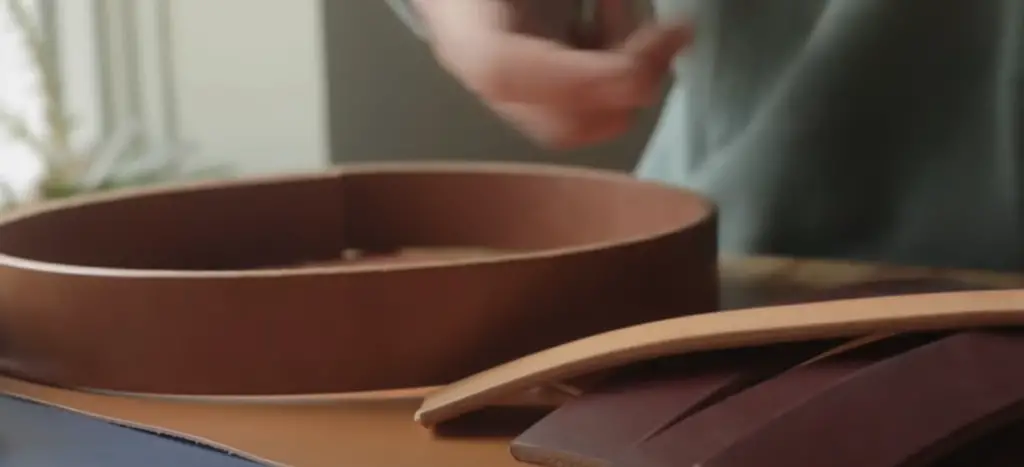
Flexibility
The best leather thickness for wallets should also be flexible. A wallet should bend easily without cracking or breaking, and it should be able to hold its shape after being bent and flexed multiple times. Quality leather will remain supple and strong even after years of use. [3]
Weight
Weight is another important factor to consider when choosing leather. A wallet should be lightweight, yet strong and durable. Leather that’s too thick can cause the wallet to feel bulky in your pocket, while a lighter weight leather will provide the same support without feeling heavy. [3]
How is Leather Thickness Measured?
Leather Thickness in Irons
Leather thickness is measured in weight, typically ounces per square foot (oz/sq ft). The heavier the leather, the thicker it will be. Higher quality leather is typically 2-3 oz., but there are also some thinner variations available.
Leather thickness can also be measured in iron units, which are used by craftsmen and leatherworkers. Irons measure the depth of a leather hide from 1/64th up to 1 inch (or more). A single iron unit is equal to 1/64th of an inch, so a leather hide that is 1/2” thick would be 8 iron units. [2]
Leather Thickness in Millimeters (mm)
Leather thickness can also be measured in millimeters (mm). One mm is equal to 0.03937 inches, so a 1/2″ thick hide would be 12.7 mm in thickness.
When selecting leather for your wallet, you should keep the thickness in mind. Leather that is too thin may tear easily and not provide enough structure and shape for your wallet. Leather that is too thick may be difficult to work with and could make your wallet bulky.
A good rule of thumb is to select leather that is between 2-3 mm thick (or 0.08 – 0.12 inches). This will provide enough structure and durability, while still being manageable when crafting your wallet. [2]
Leather Thickness in Ounces
Leather thickness is typically measured in ounces per square foot (oz/sqft). A hide that is 1 oz. thick would be the same as a leather hide that is 0.5 mm or 0.02 inches thick, but it will feel slightly thinner due to the way leather absorbs moisture and softens over time.
When selecting leather for your wallet, you should pay attention to the specified thickness. Leather that is too thin may tear, and leather that is too thick may be difficult to work with when crafting your wallet.
A good rule of thumb is to select leather that is between 1.2-3 oz. thick (or 0.08 – 0.12 inches). [2]
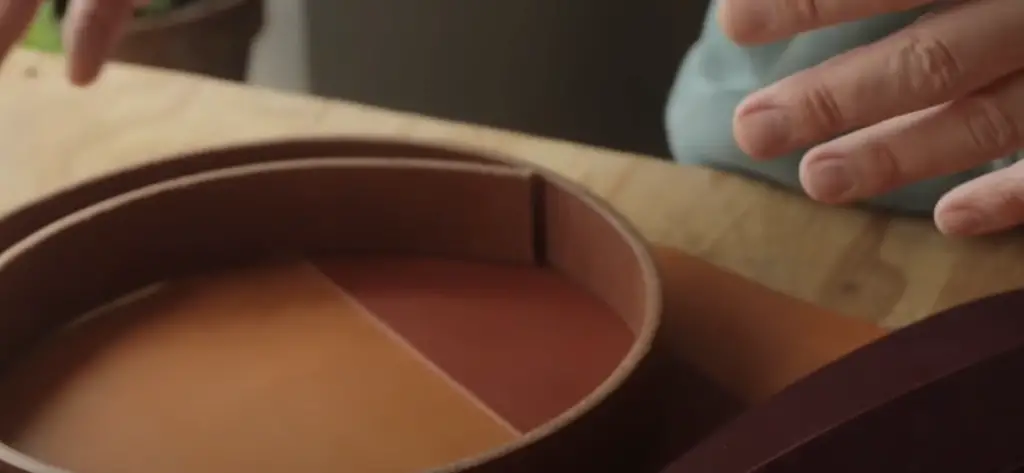
Why is Leather Measured in Ounces?
Leather is measured in ounces because the weight of leather can be used to determine its thickness. The higher the ounce measurement, the thicker the leather. Leather thickness is important when choosing a wallet because it affects durability, appearance, and feel of the product. [2]
Leather Thickness and Weight in Ranges
When choosing the best leather thickness for wallets, it’s important to understand that not all leather is created equal. Leather comes in different weights and thicknesses. Generally, leather thickness can range from 0.9mm thick to 5-6 mm thick. This means that there are different weight ranges depending on the type of wallet you choose.
One of the most popular leather types for wallets is vegetable-tanned leather. Vegetable-tanned leather is typically 1-2mm thick and has a softer, more supple feel than chrome-tanned or synthetic leathers. This type of leather works great for slim card holders or minimalist wallets as it’s lightweight and thin enough to fit in your pocket. [1]
Uses for Different Leather Thicknesses and Weights
Leather comes in a variety of thicknesses and weights, and the right leather type for your wallet depends on its intended use.
Lightweight Leather: This type of leather is best used if you’re looking for something that is lightweight and easy to carry around. These wallets typically don’t offer much protection from everyday wear and tear, but they are great for carrying a few cards and cash.
Moderate Leather: Moderate leather is great for daily use wallets because it provides adequate protection from everyday wear and tear. These wallets typically have features like card slots or pockets that make them more versatile than lighter weight leather wallets.
Heavy Duty Leather: Heavy duty leather offers the most protection against wear and tear. These wallets are great for anyone who needs to carry a lot of cash, cards, and other items. They also tend to be more expensive than lighter weight leather wallets. [1]
Tools Used to Measure Leather Thickness & Weight
Wood
A wooden last is a tool used by shoemakers and leather workers to measure the thickness and weight of leather. It consists of two flat, curved pieces that are joined at one end. The other end has a metal rod which slides through both pieces. To use it, you place the leather between the two pieces and slide the rod until it meets resistance. [4]
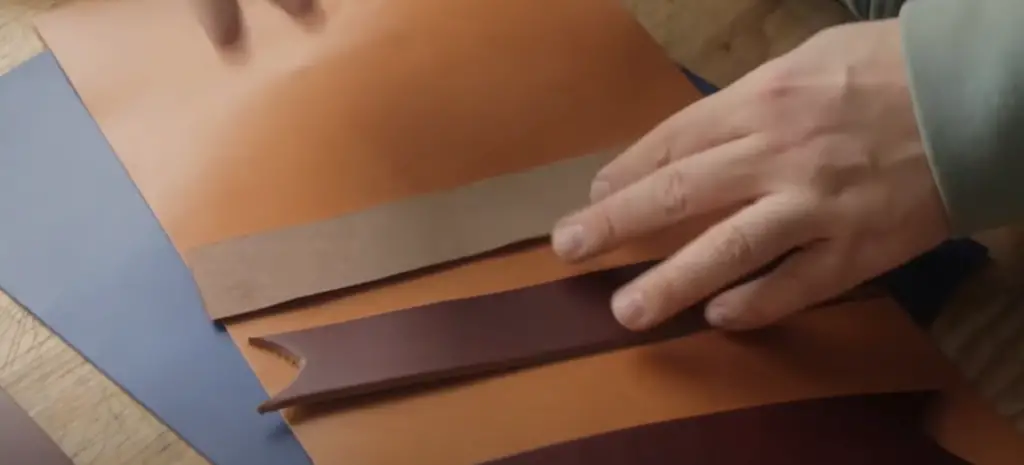
Caliper
Another tool used to measure leather is a caliper. This instrument consists of two jaws that are adjusted by turning a knob or a screw. It is placed flat on the leather and then adjusted until it meets resistance when pressed against the surface. The measurement read from the caliper will provide an accurate number for both thickness and weight. [4]
Laser Sensor
The most accurate tool used to measure leather thickness is a laser sensor. This type of instrument uses an infrared beam to measure the reflection off the surface of the leather. The laser measures with great accuracy and can provide extremely precise numbers for both weight and thickness. [4]
Leather Swatch Ring
The leather swatch ring is a tool used by leather workers to quickly estimate the weight and thickness of leather. This instrument consists of two metal rings that are connected by a piece of elastic. The rings are placed on either side of the leather, and then the elastic is adjusted until it meets resistance when pulled taut against the surface. [4]
Cobbling For Additional Leather Weights
If you’re looking for even more leather weight options than are readily available, cobbling is a great solution. Cobbling involves taking multiple pieces of leather and joining them together to create one piece at a desired thickness. This can often be done using adhesives such as glue or stitching, and the end result can give the wallet an interesting texture that looks great.
Cobbling is a great solution for those who are seeking even thicker leather than what’s available in stores, and it can also be done on the inside of the wallet to make sure that your cards fit nicely into each compartment. [3]
Leather Weights for Moccasins
When it comes to finding the right leather weight for moccasins, you have a few options. Generally speaking, the heavier the leather is, the more protective your moccasins will be from wear and tear. The lighter the leather is, however, the more comfortable it will be. It’s important to find a balance between protection and comfort, so that you can find the best leather weight for moccasins.
When it comes to leather weights, there are four main types: light (2/3 ounce), medium (4/5 ounce), heavy (7/8 ounce) and extra-heavy (1 1/2 ounces). Lightweight leather is great for creating lightweight moccasins that offer excellent breathability and comfort. Medium-weight leather is great for moccasins that will be worn in light rain or during winter months, as it provides some protection against moisture and cold temperatures. Heavy-weight leather offers the best protection against wear and tear, making them ideal for rugged terrain, outdoor activities, or working outdoors. Extra-heavy leather is generally too heavy for most moccasins, but may be used in certain circumstances. [3]
Leather Weights for Belts
Belts are among the most popular fashion accessories, and they’re also one of the most important to get right. The wrong size or style of belt can make even the best outfits look off, so it’s essential to select a good-quality leather belt that is comfortable while still looking stylish.
When it comes to choosing a leather belt, the weight of the leather plays a major role in how it will feel and look. Leather weights are measured in ounces per square foot (oz/ft2), and they range from 4-10 oz/ft2 on average. [3]

Leather Weights for Bags
When it comes to leather bags, there’s a lot of variety in terms of the leather thickness used. Different leather weights can affect how your bag looks and even how long it lasts. It’s important to identify the best leather thickness for your needs so you can make sure that your bag will be durable enough to last a long time and look stylish too.
Here are some tips for choosing the right leather weight for your bag:
- Choose a leather weight that’s appropriate to the type of bag you’re looking for. For example, a lightweight bag doesn’t need heavy leather while a more structured and heavier piece does.
- Consider your lifestyle when selecting the best leather thickness. If you’re an outdoor enthusiast, you’ll want to select a heavier leather that can take a beating and still look great.
- Pay attention to the stitches used to hold the bag together. Different weights of leather require different types of stitching for optimal strength and durability.
- Opt for vegetable tanned leather if possible. It’s the most durable type of leather and will last longer than other types.
- Consider the price when selecting a leather weight for your bag. Heavier leather is more expensive, but it might be worth it if you’re looking for a long-lasting product. [3]
Leather Weights for Watch Strap
Watch straps are important components of any watch, so selecting an appropriate leather weight is critical. The thickness of the leather strap should be sturdy enough to handle daily use and movement without becoming too stiff or uncomfortable. A thicker strap will also be better able to hold up against sweat and moisture over time.
For more formal occasions or dressy watches, you may want to opt for something a bit thicker and stronger – like cowhide leather at 4-5.5mm thickness. [1]
Leather Weights for Knife Sheaths
When deciding on the best type of leather for your knife sheath, one of the most important considerations is the weight. Leather weights are used to measure how thick a piece of leather is.
Different types of leather will have different weight ranges, and not all types of leather are suitable for making a knife sheath. So it’s important to understand and choose the right leather weight for your project.
The most common leather weights used to make knife sheaths are generally between 2-4 ounces; however, there are heavier and lighter varieties available too. Generally speaking, the thicker the leather is, the more durable it will be over time. [1]
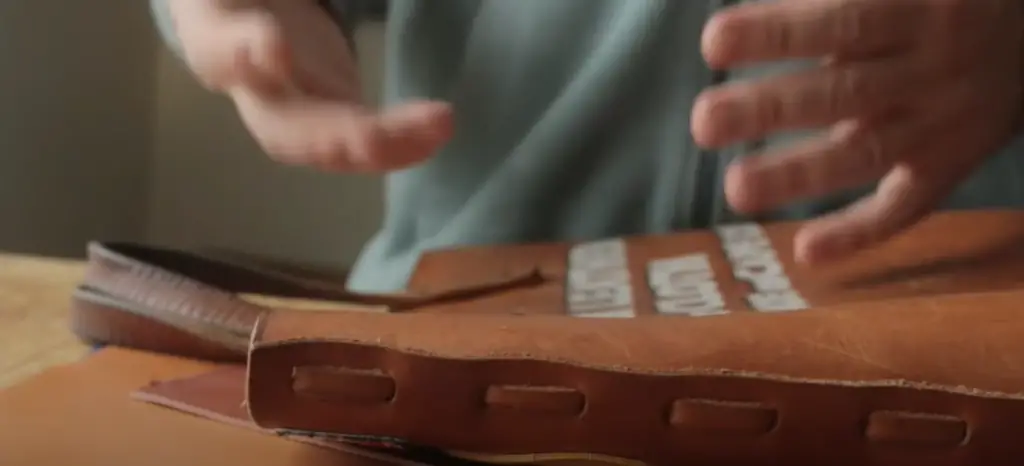
Weight of Leather for Holsters
When it comes to holsters, leather thickness matters. The weight of the leather affects the comfort and usability of your holster. Leather that is too thin won’t last as long and may not provide enough protection for your gun’s finish. On the other hand, leather that is too thick can be bulky and hard to carry around comfortably.
The best leather thickness for holsters depends on the type of gun that you carry and the environment in which you will be carrying it. For example, if you live in a colder climate or plan to use your holster while out hunting, then thicker leather can provide added warmth and protection. [2]
FAQ
What cut of leather is best for wallets?
When it comes to choosing the best cut of leather for wallets, the answer will depend on what type of wallet you’re looking for. Generally speaking, most wallets are crafted with full-grain leather, which is one of the highest quality cuts available. Full-grain leather has not had any surface corrections or alterations made to it and retains its natural grain pattern, making it incredibly durable and able to withstand the wear-and-tear of everyday use.
What is the best thickness of leather?
The best thickness of leather for wallets will depend on the type of wallet and your personal preference. Generally speaking, a thicker leather is more durable and long-lasting than a thinner leather, however it may also be less flexible if you’re looking for something that can easily fit in your pocket or purse. If you’re looking for a wallet that stands the test of time, look for a leather that is at least 1.6 to 2.2 mm thick (about 6 to 8 oz). If you prefer something more lightweight and less bulky, then you can opt for something thinner like 0.8 mm (3 oz) or 1.2 mm (4-5 oz).
Is 1.2 mm leather good?
Yes, 1.2 mm leather is good for wallets and can still provide a decent amount of durability. It’s slightly thinner than the recommended thickness for everyday use, but it may be an ideal choice if you’re looking for something lightweight and less bulky that can easily fit in your pocket or purse. Keep in mind that while 1.2 mm leather is good, it won’t last as long as thicker leather and may require more frequent upkeep.
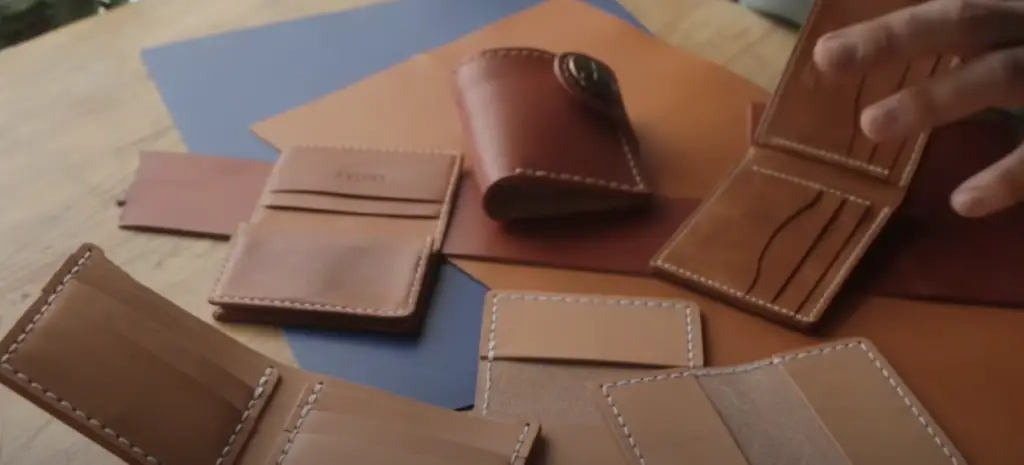
How thick is 1.5 mm leather?
1.5mm is a medium-thickness of leather, and ideal for wallets that will get regular use. At this thickness, the leather is still thin enough to not feel bulky in your pocket or purse but it’s also thick enough to stand up against everyday wear-and-tear. 1.5 mm leather is about 5-6 oz, which is a good balance between durability and flexibility.
Is 1.2 mm thick for a leather jacket?
No, 1.2 mm leather is too thin for a leather jacket. For jackets, you’ll want something much thicker – at least 2.2 mm to 3.2 mm (8 to 11 oz). A thicker leather will keep you warmer and provide more protection against the elements, while still being flexible enough for everyday use.
How thick is Alpinestars leather?
Alpinestars leather is 1.2 mm thick, which is perfect for motorcycle jackets and other protective gear. By using such a thin leather, Alpinestars are able to make their garments lightweight without sacrificing strength or durability. This allows the wearer to move freely while still having protection from the elements.
Does thickness of leather matter?
Yes, the thickness of leather does matter when it comes to wallets and other clothing items. Thicker leather is more durable and long-lasting than thinner leather, however it may also be less flexible if you’re looking for something that can easily fit in your pocket or purse. Ultimately, the best thickness of leather will depend on what type of wallet or garment you’re looking for and your personal preference.
How thick is lambskin leather?
Lambskin leather is usually 1.2 mm or thinner, making it ideal for wallets and other accessories that need to be light and flexible. Lambskin leather is also known for its silky-smooth feel and luxurious look, so it’s perfect for those looking to add a touch of sophistication to their style. It may not be the most durable leather, but it’s certainly a great option if you’re looking for something lightweight and stylish.
Useful Video: Leather Thickness Explained | Finding the Right Thickness for Your Project
Conclusion
Overall, there are many factors to consider when it comes to picking the best leather thickness for wallets. When compared to other materials, leather offers a variety of benefits that make it an ideal choice. It has long-lasting durability and is resistant to wear and tear, making it a great option for those who want their wallets to last through everyday use. Additionally, leather wallets come in a wide range of thicknesses, so you can choose the best one to suit your lifestyle and needs.
Ultimately, it is up to you to decide which leather thickness is the right choice for your wallet. Consider factors such as how often you plan on using it, what types of items you want to store in it, and how much protection from damage you need. With the right information and understanding of the different leather thickness options, you can make sure your wallet is just right for you. Good luck!
References:
- https://www.libertyleathergoods.com/leather-thickness-weight/
- https://www.allthewallets.com/how-to-choose-leather-thickness/
- https://www.andar.com/blogs/blog/leather-thickness-chart
- https://favoredleather.com/perfect-leather-weights-and-their-uses/

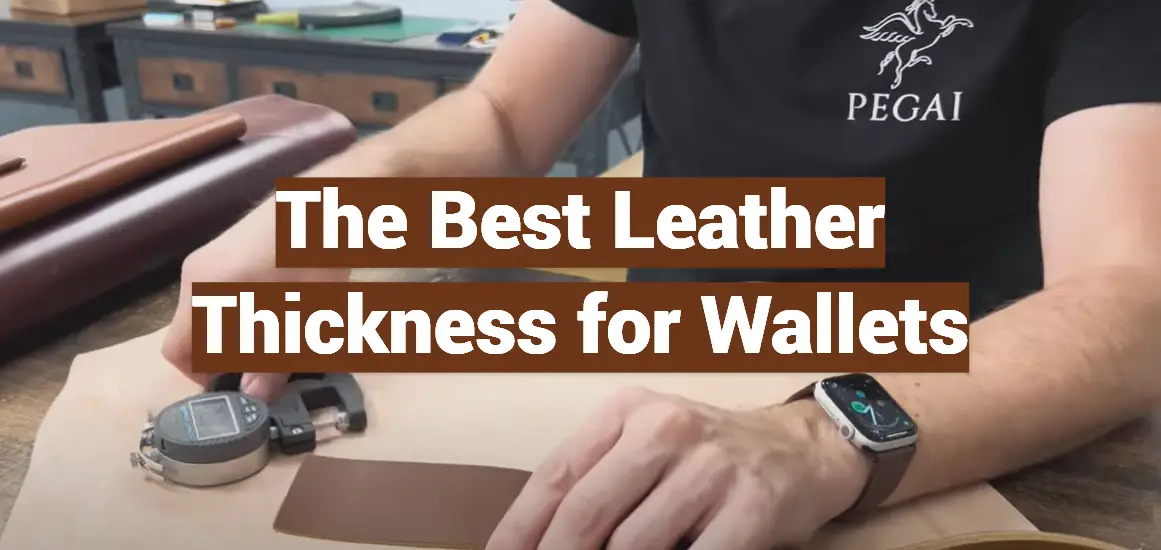



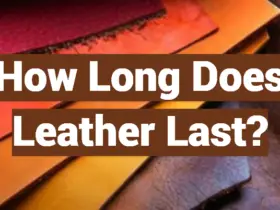

Leave a Reply